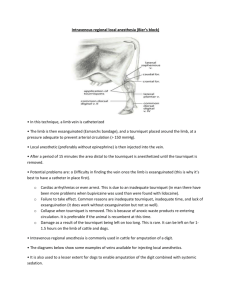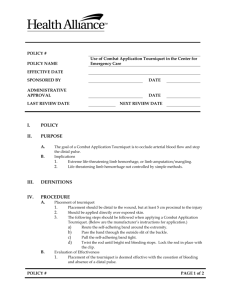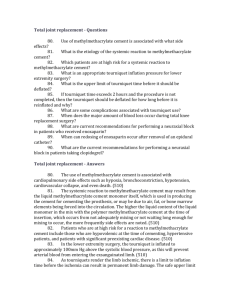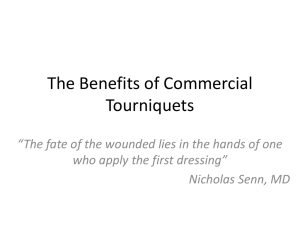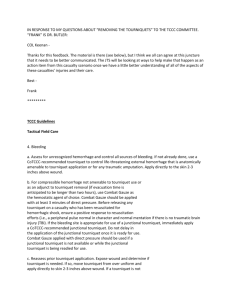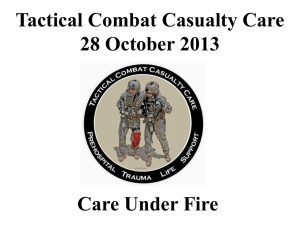Document 5592576
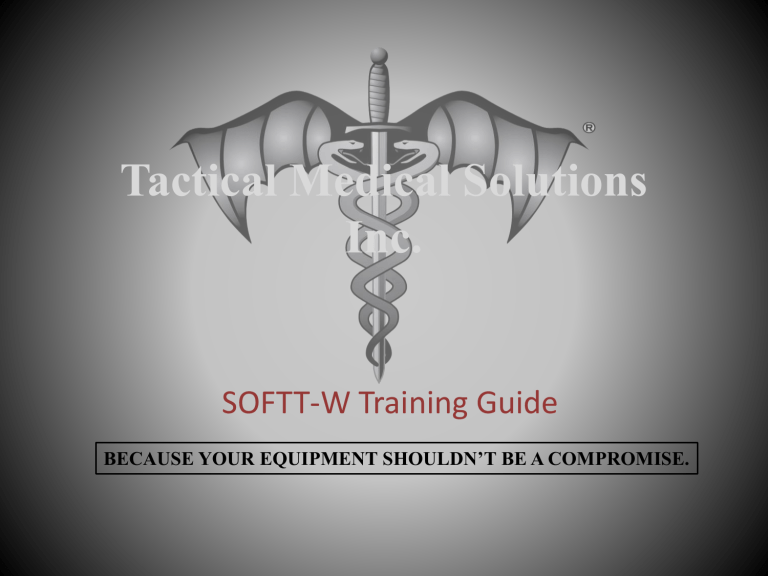
Tactical Medical Solutions
Inc.
SOFTT-W Training Guide
BECAUSE YOUR EQUIPMENT SHOULDN’T BE A COMPROMISE.
SOF TACTICAL TOURNIQUET- WIDE
PART# SOFTT-W
THE SOF TACTICAL TOURNIQUET WIDE
IS THE BEST TOURNIQUET ON THE
MARKET TODAY. NOW WITH A WIDER
CONSTRICTING BAND AND QUICK
RELEASE BUCKLE, THE SOFTT-W IS
MUCH FASTER AND 25% LIGHTER THAN
ITS PREDECESSOR.
THE QUICK RELEASE BUCKLE
ELIMINATES THE NEED TO EVER
UNTHREAD AND RETHREAD THE
CONSTRICTING BAND.
THE SOFTT-W HAS THE SAME SOLID
CONSTRUCTION AS THE GENERATION II,
NOW IN A SMALLER, LIGHTER, FASTER
PACKAGE.
SOF TACTICAL TOURNIQUET- WIDE
MATERIAL IS PROVIDED FOR TRAINING PURPOSES ONLY.
WHEN USING ANY MEDICAL DEVICE OR PERFORMING A
LIFE SAVING PROCEDURE SUCH AS APPLYING A
TOURNIQUET, UNIT STANDARD OPERATING
PROCEDURES SHOULD BE FOLLOWED. PROPER TRAINING
SHOULD BE CONDUCTED WHEN A DEVICE SUCH AS A
TOURNIQUET IS ISSUED. EFFECTIVE TRAINING ALONG
WITH QUALITY EQUIPMENT WILL GREATLY INCREASE
SURVIVABILITY OF THE TACTICAL PROFESSIONAL.
Anatomy of the SOF Tactical Tourniquet
TRI-RING
WINLASS
BASE
QUICK ATTACH
BUCKLE
CONSTRICTING
BAND
The Man,
The Myth,
The Legend
• Myth
– Applying a tourniquet will result in the loss of the limb it is applied to. (FALSE)
• Fact
– There is not an established ‘SAFE’ amount of time to leave a tourniquet in place. Factors specific to each patient would dictate this period of time
– Cases exist of patients in the US and abroad in which a tourniquet has remained in place for 4 hours or more without permanent damage being caused
– Tourniquets are the fastest, easiest, most effective way to stop arterial and major venous bleeding of an extremity
Carry and Deployment
• Your SOF Tactical Tourniquet should be quickly and easily accessible with either hand
• Stow in ‘Ready’ status
– Do not stow with rubber bands around the TQ
– Buckle should be cliped and sized out to fit your leg
• Your wound, your tourniquet
– Utilize your patients tourniquet first
– If not- your patient leaves with your tourniquet and theirs
Recognize The Need
• Error on the side of caution
– Remember, you’re not going to lose a limb by putting a tourniquet on yourself or another
– You might lose a life if you don’t
• Closed fracture application
– Blood belongs in the circulatory system, in the body isn’t good enough
– Remember Point One- Error on the side of caution
Tourniquet Placement-Post Placement
• Place tourniquet as high as possible on the affected limb
– Arteries can retract when an injury occurs
– Tourniquet placed only inches above a wound may not occlude bleeding
• When possible, tourniquet should be in direct contact with skin, not over clothing
• Monitor the TQ to ensure that it remains effectively in place
Is Your Application Effective?
• An effective application will result in a stoppage of blood flow and…
• Absence of the distal pulse
LETS PUT IT ON!!
1
SOF TACTICAL TOURNIQUET- WIDE
BEGIN BY RELEASING THE QUICK
DISCONNECT BUCKLE. ROUTE
THE CONSTRICTING BAND
AROUND THE INJURED LIMB AS
PICTURED BELOW, AND
RECONNECT THE BUCKLE.
REFER TO YOUR UNIT SOP FOR
TOURNIQUET PLACEMENT AND
POSITIONING. AS PICTURED,
TOURNIQUET IS PLACED HIGH
ON THE LEG REGARDLESS OF
WHERE THE BLEED IS LOCATED.
2
3
SOF TACTICAL TOURNIQUET- WIDE
REMOVE SLACK BY PULLING ON THE LOOSE
END OF THE CONSTRICTING BAND.
REMOVING AS MUCH SLACK AS POSSIBLE AT
THIS STAGE OF THE APPLICATION WILL
INCREASE EFFICACY WHEN WINDLESS IS
TURNED.
TURN WINDLESS UNTIL BLEEDING
STOPS COMPLETELY. WOUND
MAY CONTINUE TO SEEP BUT
THERE SHOULD BE NO ACTIVE
BLOOD FLOW. STOW END OF
HANDLE IN THE TRI-RING.
4
SOF TACTICAL TOURNIQUET- WIDE
ANNOTATE TIME IN ACCORDANCE WITH UNIT SOP.
CASES OF TOURNIQUETS BEING IN PLACE IN EXCESS
OF 5 HOURS HAVE BEEN NOTED WITH THE PATIENT
EXHIBITING NO PERMANENT LOSS OF FEELING OR
DEATH OF TISSUE.
5
WINDLESS PROPERLY
STOWED IN TRI-RING
ONCE BLEEDING IS
CONTROLLED.
THE USE OF A TOURNIQUET SHOULD BE
CONSIDERED AS A PRIMARY MEANS OF
STOPPING SEVERE BLEEDING IN AN
EXTREMITY.
SOF TACTICAL TOURNIQUET- WIDE
ONE HANDED APPLICATION
OPTIMAL ONE HANDED APPLICATION SHOULD BE PERFORMED IN ONE OF THREE WAYS.
THESE THREE TECHNIQUES REPRESENT REAL WORLD ONE HANDED TOURNIQUET
APPLICATIONS AND HOW THEY ARE ACHIEVED OUTSIDE OF THE CLASSROOM.
USING CHEEK TO
IMMOBILIZE TQ WHILE
SLACK IS REMOVED.
LYING DOWN WITH
INJURED SIDE PRESSED
AGAINST THE GROUND.
LEANING AGAINST A
STRUCTURE OF ANY KIND.
IE. BUILDING OR TREE.
NOTE: WHILE TRAINING ON ONE HANDED TOURNIQUET APPLICATION SHOULD
BE CONDUCTED, KEEP IN MIND THAT ONE HANDED APPLICATIONS ACCOUNT
FOR LESS THAN 1% OF ALL REAL WORLD TOURNIQUET USES.
SOF TACTICAL TOURNIQUET- WIDE
APPLICATION- SINGLE SLIDE
THE SOFTT-W IS APPLIED THE SAME WAY
WHETHER IT BE ON AN ARM OR LEG.
REMOVE AS MUCH SLACK AS POSSIBLE
BEFORE BEGINNING TO TWIST THE
WINDLESS. TWIST WINDLESS UNTIL
HEMORRHAGE IS CONTROLLED, AND STOW
THE HANDLE INSIDE OF THE TRI-RING AS
PICTURED.
